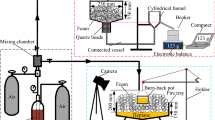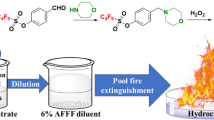Abstract
The application of conventional aqueous film-forming foam (AFFF) has been severely restricted due to the serious environmental hazard caused by the key component, fluorocarbon surfactants. Environmental-friendly fluorine-free firefighting foams need to be developed urgently. In this study, five silicone surfactants are chosen as key component to prepare fluorine-free firefighting foams. The aqueous solution properties of the fluorine-free firefighting foams are studied in details, including surface tension, interfacial tension, spreading property, viscosity and foaming ability. Foam drainage and foam spread on heptane surface are analyzed. Fire extinguishing and burn-back performance of fluorine-free foams is evaluated based on a small-scale standard method. Particularly, fire extinguishing and burn-back performance of a commercial AFFF is also evaluated as a comparison. Results show that fluorine-free foams cannot form aqueous film on cyclohexane surface, no matter whether spreading coefficient is greater than zero or not. Fluorine-free foams exhibit much better foam stability but worse foam spread property than commercial AFFF. Not all the fluorine-free foams containing silicone surfactant performed as well as AFFF containing fluorocarbon surfactant. Only fluorine-free foam containing silicone surfactant of OFX-5211 shows better fire extinguishing and burn-back performance than AFFF. The higher efficiency of fluorine-free foam in fire extinguishing and burn-back should be attributed to the stronger foam stability.









Similar content being viewed by others
References
Mudan KS (1984) Thermal radiation hazards from hydrocarbon pool fires. Prog Energy Combust Sci 10:59–80
Siddapureddy S, Wehrstedt KD, Prabhu SV (2016) Heat transfer to bodies engulfed in di-tert-butyl peroxide pool fires-Numerical simulations. J Loss Prev Process Ind 44:204–211
Guiberti TF, Cutcher H, Roberts WL, Masri AR (2017) Influence of pilot flame parameters on the stability of turbulent jet flames. Energy Fuels 31:2128–2137.
Saisirirat P, Foucher F, Chanchaona S, Mounaïmrousselle C (2010) Spectroscopic measurements of low-temperature heat release for homogeneous combustion compression ignition (HCCI) n-Heptane/Alcohol mixture combustion. Energy Fuels. 24:5404–5409
Kong D, Liu P, Zhang J, Fan M, Tao C (2017) Small scale experiment study on the characteristics of boilover. J Loss Prev Process Ind 48:101–110
Hu L, Wang Q, Delichatsios M, Lu S, Tang F (2014) Flame radiation fraction behaviors of sooty buoyant turbulent jet diffusion flames in reduced-and normal atmospheric pressures and a global correlation with Reynolds number. Fuel 116:781–786
Bouhafid A, Vantelon JP, Souil JM, Bosseboeuf G, Rongere FX (1989) Characterisation of thermal radiation from freely burning oil pool fires. Fire Saf J 15:367–390
Ditch BD, de Ris JL, Blanchat TK, Chaos M, Bill RGJr, Dorofeev SB (2013) Pool fires—an empirical correlation. Combust Flame 160:2964– 2974
Kong D, Zhang Z, Ping P, Chen G, He X, Yang H (2018) Experimental study on burning behavior of crude oil pool fire in annular ice cavities. Fuel 234:464–472
Hu L, Liu S, Wu L (2013) Flame radiation feedback to fuel surface in medium ethanol and heptane pool fires with cross air flow. Combust Flame 160:295–306
Schaefer TH, Dlugogorski BZ, Kennedy EM (2008) Sealability properties of fluorine free firefighting foams (FfreeF), Fire Technol 44:297–309
Lattimer BY, Hanauska CP, Scheffey JL, Williams FW (2003) The use of small-scale test data to characterize some aspects of firefighting foam for suppression modeling, Fire Saf J 38:117–146
Sheng Y, Jiang N, Lu S, Li C (2018) Fluorinated and fluorine-free firefighting foams spread on heptane surface. Colloid Surface A 552:1–8
Sheng Y, Lu S, Xu M, Wu X, Li C (2016) Effect of Xanthan gum on the performance of aqueous film-forming foam. J Dispers Sci Technol 37:1664–1670
Zhang Q, Wang L, Bi Y, Xu D, Zhi H, Qiu P (2015) Experimental investigation of foam spread and extinguishment of the large-scale methanol pool fire. J Hazard Mater 287:87–92
Laundess AJ, Rayson MS, Kennedy EM, Dlugogorski BZ (2011) Small-scale test protocol for firefighting foams DEF (AUST) 5706: effect of bubble size distribution and ER. Fire Technol 47:149–162
Magrabi SA, Dlugogorski BZ, Jameson GJ (2001) Free drainage in aqueous foams: model and experimental study, AICHE J 47:314–327
Magrabi SA, Dlugogorski BZ, Jameson GJ (2002) A comparative study of drainage characteristics in AFFF and FFFP compressed-air firefighting foams. Fire Saf J 37:21–51
Kishi T, Mitsuru A (2008) Study on the generation of perfluorooctane sulfonate from the aqueous film-forming foam. J Hazard Mater 159:81–86
Schaefer CE, Andaya C, Urtiaga A, McKenzie ER, Higgins CP (2015) Electrochemical treatment of perfluorooctanoic acid (PFOA) and perfluorooctane sulfonic acid(PFOS) in groundwater impacted by aqueous film forming foams (AFFFs). J Hazard Mater 295:170–175
Rodriguez-Freire L, Abad-Fernández N, Sierra-Alvarez R, Hoppe-Jones C, Peng H, Giesy JP, Keswani M (2016) Sonochemical degradation of perfluorinated chemicals in aqueous film-forming foams. J Hazard Mater 317:275–283
Sheng Y, Wu X, Lu S, Li C (2016) Experimental study on foam properties of mixed systems of silicone and hydrocarbon surfactants. J Surfactants Deterg 19(4): 823–831
Hetzer R, Kümmerlen F, Wirz K, Blunk D (2014) Fire testing a new fluorine-free AFFF based on a novel class of environmentally sound high performance siloxane surfactants. Fire Saf Sci 11:1261–1270o
Wang P (2015) Application of green surfactants developing environment friendly foam extinguishing agent. Fire Technol 51(3):503–511
Vinogradov AV, Kuprin DS, Abduragimov IM, Kuprin GN, Serebriyakov E, Vinogradov VV (2016) Silica foams for fire prevention and firefighting. ACS Appl Mater Inter 8(1):29–301
Kennedy M, Conroy M, Dougherty J, Otto N, Williams B, Ananth R, Fleming J (2015) Bubble coarsening dynamics in fluorinated and non-fluorinated firefighting foams. Colloid Surface A 470:268–279
Hinnant KM, Conroy MW, Ananth R (2017) Influence of fuel on foam degradation for fluorinated and fluorine-free foams. Colloids Surf A 522:1–17
Dlugogorski BZ, Phiyanalinmat S, Kennedy EM (2005) Dynamic surface and interfacial tension of AFFF and Fluorine-Free Class B foam Solutions. In: Fire safety science: Procedings of the eighth international symposium, pp 719–730
Sheng Y, Jiang N, Sun X, Lu S, Li C (2018) Experimental study on effect of foam stabilizers on aqueous film-forming foam. Fire Technol 54(1):211–228
Sheinson RS, Williams BA, Green C, Fleming JW, Anleitner R, Ayers S, Barylski D (2002) The future of aqueous film forming foam (AFFF): performance parameters and requirements. Naval Research Laboratory
Moran HE, Burnett JC, Leonard JT (1971) Suppression of Fuel Evaporation by Aqueous Films of Fluorochemical Surfactant Solutions (No.NRL-7247). Naval Research Lab Washington DC
Svitova T, Hoffmann H, Hill RM (1996) Trisiloxane surfactants: surface/interfacial tension dynamics and spreading on hydrophobic surfaces. Langmuir 12(7):1712–1721
Rosen MJ, Kunjappu JT (2012) Surfactants and interfacial phenomena. Wiley, New Jersey, pp 308–331
Sheng Y, Lu S, Jiang N, Wu X, Li C (2018) Drainage of aqueous film-forming foam stabilized by different foam stabilizers. J Dispers Sci Technol 39(9):1266–1273
Acknowledgements
The present work was supported by The National Natural Science Foundation of China (No. 51904230), China Postdoctoral Science Foundation (No. 2019M653700), Key R&D plan of Shaanxi Province (2017ZDXM-SF-092), Opening Fund of State Key Laboratory of Fire Science (No. HZ2019-KF03), and Doctor Initial Funding of Xi’an University of Science and Technology (No. 6310118032).
Author information
Authors and Affiliations
Corresponding author
Additional information
Publisher's Note
Springer Nature remains neutral with regard to jurisdictional claims in published maps and institutional affiliations.
Rights and permissions
About this article
Cite this article
Sheng, Y., Jiang, N., Lu, S. et al. Study of Environmental-Friendly Firefighting Foam Based on the Mixture of Hydrocarbon and Silicone Surfactants. Fire Technol 56, 1059–1075 (2020). https://doi.org/10.1007/s10694-019-00920-x
Received:
Accepted:
Published:
Issue Date:
DOI: https://doi.org/10.1007/s10694-019-00920-x




